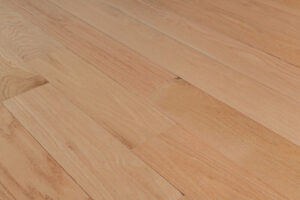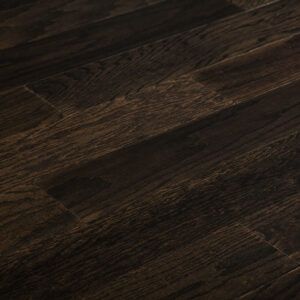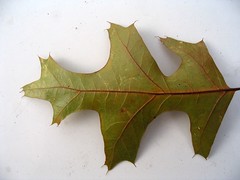What is Red Oak Hardwood Flooring?
Fast Facts About Red Oak
Color: Heartwood is light to medium brown with a reddish tone; sapwood is pale creamy white to light reddish tan.
Grain: Open grain with a coarse, porous texture and a wide range of figuring. Quartersawn planks have a flake, or butterfly patterning.
Variations within Species and Grades: There are more than 200 subspecies of red oak in North America providing a great deal of variation in color and grain.
Hardness/Janka: Northern red oak is the median benchmark of the scale at 1,290. Southern red oak is a little softer and rates 1,060.
Dimensional Stability: 8.6 for northern (benchmark rating) and 11.3 for southern red oak.
Sawing/Machining: Easy to saw and machine.
Sanding: Sands well when sanded in proper sequence.
Nailing: No nailing problems.
Finishing: Stains well and shows strong staining contrast. It bleaches better than white oak due to lack of tannins that can affect the color of white oak.
Availability: Widely available.
What is Red Oak?

Red oak is a deciduous hardwood with 40 species and more than 200 subspecies indigenous to North America, southeastern Canada, Mexico and Central America. It was introduced to Europe in the 18th century and continues to flourish there. Color ranges from a pale tan to a medium brown with a reddish hue.
The grain is open, and the texture of the wood is coarse and porous with a dull luster. Grain patterns are determined by machining; plainsawn lumber has a grain pattern with a plumed or flared appearance, riftsawn planks are tightly grained, and quartersawn planks have a flaked pattern, also known as tiger rays or butterflies.
North vs. South
Northern red oak is the species most noted for adaptability. It is a hardy species that flourishes in many different kinds of soils and environments, making it one of the most readily available hardwoods on the market. The northern red oak tree grows fairly quickly to an average size of 115-140 feet in height and up to 4 feet in diameter.
The grain pattern of the northern red oak is distinctive, with shiny, silvery waves, curls, and stripes. Southern red oak is softer and less durable, and tends to be lighter in color with less distinctive grain marking. It is an adaptable type of tree, noted for faster growth. It is easy to work with and quite durable when properly dried, but is more commonly used for furniture, while northern red oak is more commonly used for flooring.
Red Oak Usage

Red oak became a favorite choice of wood early for the American colonists and English craftsmen, prized for its color, grain, and workability. It is historically used for interior woodwork and paneling, furniture, boxes and crates, coffins, timbers, pallets, handles, agricultural tools, and flooring. Because it is extremely porous, it is not used on boats or for wine barrels.
Durability
Red Oak is the median standard, rated at 1,290 on the Janka hardness scale, making it a great choice for flooring. It’s not so hard that it scratches easily, but not so soft that it dents easily. The Janka hardness scale uses 0.444” steel ball pushed into a 2’’ x 2’’ x 6’’ piece to determine how hard the wood is. This test determines out how many pounds per square inch, or PSI, of force is needed to push the steel ball half way into the wood plank.
Red oak flooring is manufactured as solid planks or as veneer surfaces for engineered flooring. As a hardwood, you can sand and refinish it up to seven times over the life of the floor. You can sand high-end engineered flooring up to five times. High-end manufactured flooring can be as costly – or more – than solid wood, but has advantages in areas of high humidity and can be installed at or below grade, unlike solid wood. You should not sand lower-end engineered flooring, but you can strip and re-varnish. Read the manufacturers instructions for specific details about your flooring product.
Workability

Red oak is one of the easiest woods to work with. It sands well and takes stain better than white oak because it lacks the membranous growth called tyloses found in white oak that makes it nearly impenetrable to water. We recommend pre-boring the wood, but it will hold the nails well without boring. Red oak flooring can be floated, nailed, or stapled, and is especially good for glued applications.
Where to Use
Red oak brings natural warmth and adds charm to any décor, but it’s best to avoid rooms where standing water is common, like bathrooms. Red oak is very porous and will soak up a lot of water, causing the floor to buckle and warp. You can use it in almost any room, but will be best in areas with medium to low traffic. Placing pads under furniture legs, rugs or runners in high traffic areas, and keeping pet nails clipped will help protect your red oak floor and keep it looking good for decades.
Care and Maintenance for Red Oak Flooring
All wood flooring is easy to care for when treated with respect, but prone to dents and scratches from heavy traffic, impacts, spiked shoes, furniture, or pet nails. Excess water will stain and damage your beautiful floor, so it is imperative to clean up wet spills immediately. Regular sweeping or vacuuming and an occasional pass with a damp mop is all the care needed. If you have a waxed floor, an occasional buffing will restore the shine and remove any scuff marks.
Environmental Issues
Red oak has a relatively fast maturity and superior adaptability, so it is a highly sustainable resource. It is also an environmentally sound resource when harvested from approved sources. Since most red oak flooring is grown and manufactured in North America, it is logged legally and forested responsibly.



Rick Morgan
I am thinking about building a school podium for my daughter and she would like it made out of red oak. Do you know of any Oklahoma City dealers that might be able to help me? If not the nearest dealer would be fine. The podium would be of standard size.
Regards
Rick Morgan
Linda Lee
Is northern red oak busier looking than southern red oak?